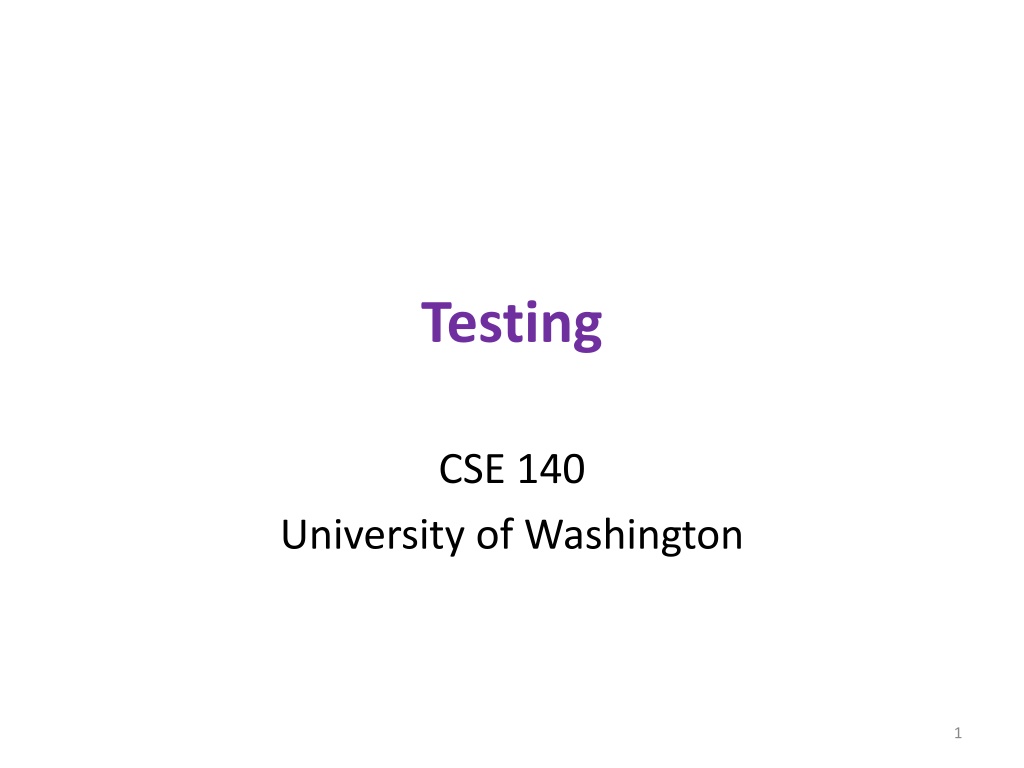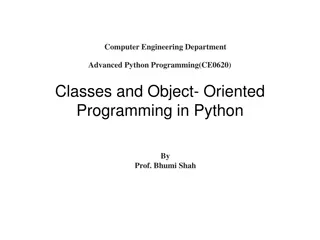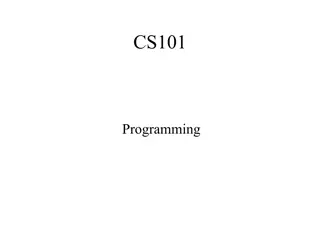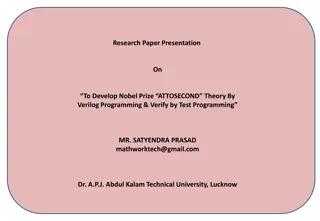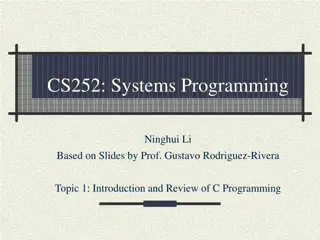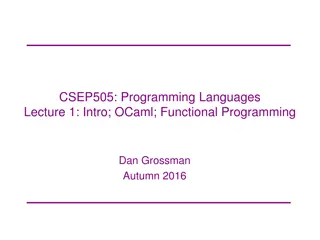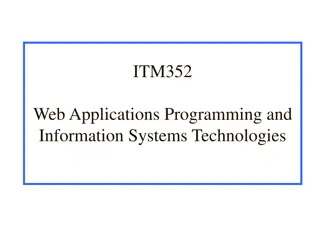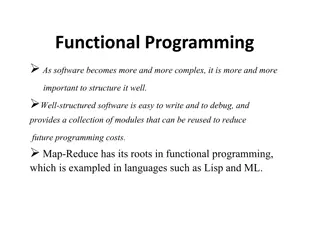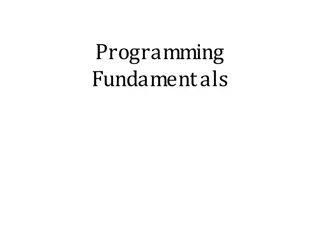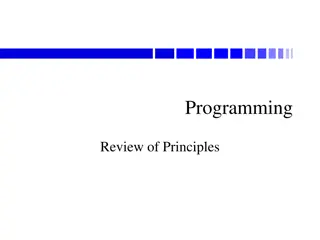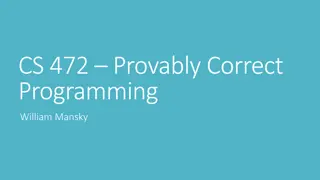Importance of Correctness in Programming Analysis
Testing and programming for data analysis require prioritizing correctness over speed to avoid critical errors. Learn about famous examples and strategies for effective testing and debugging in programming.
Download Presentation

Please find below an Image/Link to download the presentation.
The content on the website is provided AS IS for your information and personal use only. It may not be sold, licensed, or shared on other websites without obtaining consent from the author. Download presentation by click this link. If you encounter any issues during the download, it is possible that the publisher has removed the file from their server.
E N D
Presentation Transcript
Testing CSE 140 University of Washington 1
Testing Programming to analyze data is powerful It s useless if the results are not correct Correctness is far more important than speed 2
Famous examples Ariane 5 rocket Therac-25 radiation therapy machine 3
Testing does not prove correctness Edsger Dijkstra: Program testing can be used to show the presence of bugs, but never to show their absence! 4
Testing = double-checking results How do you know your program is right? Compare its output to a correct output How do you know a correct output? Real data is big You wrote a computer program because it is not convenient to compute it by hand Use small inputs so you can compute by hand Example: standard deviation What are good tests for std_dev? 5
Testing debugging Testing: determining whether your program is correct Doesn t say where or how your program is incorrect Debugging: locating the specific defect in your program, and fixing it 2 key ideas: divide and conquer the scientific method 6
What is a test? A test consists of: an input (sometimes called test data ) an oracle (a predicate (boolean expression) of the output) Example test for sum: input: [1, 2, 3] oracle: result is 6 write the test as: sum([1, 2, 3]) == 6 Example test for sqrt: input: 3.14 oracle: result is within 0.00001 of 1.772 ways to write the test: sqrt(3.14) 1.772 < 0.00001 and sqrt(3.14) 1.772 > -0.00001 -0.00001 < sqrt(3.14) 1.772 < 0.00001 math.abs(sqrt(3.14) 1.772) < 0.00001 7
Test results The test passes if the boolean expression evaluates to True The test fails if the boolean expression evaluates to False Use the assert statement: assert sum([1, 2, 3]) == 6 assert math.abs(sqrt(3.14) 1.772) < 0.00001 assert True does nothing assert False crashes the program and prints a message 8
Where to write test cases At the top level: is run every time you load your program def hypotenuse(a, b): assert hypotenuse(3, 4) == 5 assert hypotenuse(5, 12) == 13 In a test function: is run when you invoke the function def hypotenuse(a, b): def test_hypotenuse(): assert hypotenuse(3, 4) == 5 assert hypotenuse(5, 12) == 13 9
Assertions are not just for test cases Use assertions throughout your code Documents what you think is true about your algorithm Lets you know immediately when something goes wrong The longer between a code mistake and the programmer noticing, the harder it is to debug 10
Assertions make debugging easier Common, but unfortunate, course of events: Code contains a mistake (incorrect assumption or algorithm) Intermediate value (e.g., in local variable, or result of a function call) is incorrect That value is used in other computations, or copied into other variables Eventually, the user notices that the overall program produces a wrong result Where is the mistake in the program? It could be anywhere. Suppose you had 10 assertions evenly distributed in your code When one fails, you can localize the mistake to 1/10 of your code (the part between the last assertion that passes and the first one that fails) 11
Where to write assertions Function entry: are arguments legal? Place blame on the caller before the function fails Function exit: is result correct? Places with tricky or interesting code Assertions are ordinary statements; e.g., can appear within a loop: for n in myNumbers: assert type(n) == int or type(n) == float 12
Where not to write assertions Don t clutter the code (Same rule as for comments) Don t write assertions that are certain to succeed The existence of an assertion tells a programmer that it might possibly fail Don t write an assertion if the following code would fail informatively assert type(name) == str "Hello, " + name Write assertions where they may be useful for debugging 13
What to write assertions about Results of computations Correctly-formed data structures assert 0 <= index < len(mylist) assert len(list1) == len(list2) 14
When to write tests Two possibilities: Write code first, then write tests Write tests first, then write code It s best to write tests first If you write the code first, you remember the implementation while writing the tests You are likely to make the same mistakes in the implementation If you write the tests first, you will think more about the functionality than about a particular implementation You might notice some aspect of behavior that you would have made a mistake about 15
Write the whole test A common mistake: 1. Write the function 2. Make up test inputs 3. Run the function 4. Use the result as the oracle You didn t write a test, but only half of a test Created the tests inputs, but not the oracle The test does not determine whether the function is correct Only determines that it continues to be as correct (or incorrect) as it was before 16
Tests are for specified behavior def roots(a, b, c): """Returns a list of the two roots of ax**2 + bx + c.""" ... Bad test of implementation-specific behavior: assert roots(1, 0, -1) == [1, -1] Assertions inside a routine can be for implementation-specific behavior 17
Tests prevent you from introducing errors when you change a function Abstraction: the implementation details do not matter Preventing introducing errors when you make a change is called regression testing 18
Write tests that cover all the functionality Think about and test corner cases Empty list Zero int vs. float values 19
Testing Approaches Black box testing - Choose test data without looking at implementation Glass box (white box, clear box) testing - Choose test data with knowledge of implementation 20
def isPrime(x): """Assumes x is a nonnegative int Returns True if x is prime; False otherwise""" if x <= 2: return False for i in range(2, x): if x%i == 0: return False return True 21
Tests might not reveal an error def mean(numbers): """Returns the average of the argument list. The argument must be a non-empty list of numbers.""" return sum(numbers)/len(numbers) # Tests assert mean([1, 2, 3, 4, 5]) == 3 assert mean([1, 2.1, 3.2]) == 2.1 This implementation is elegant, but wrong! mean([1,2,3,4]) 22
Dont write meaningless tests def mean(numbers): """Returns the average of the argument list. The argument must be a non-empty list of numbers.""" return sum(numbers)/len(numbers) Unnecessary tests. Don t write these: mean([1, 2, "hello"]) mean("hello") mean([]) 23
